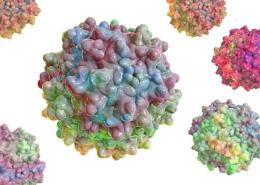Deploying DNA-Delivery Trucks To Fix Genetic Diseases


The adeno-associated virus (green) can infect a wide range of vertebrates without causing symptoms. It needs a helper virus like the adenovirus (orange) to replicate. (Science Photo Library)
A benign virus, turned DNA-delivery truck, may hold the potential to repair gene malfunctions that can trigger disease.
Over millions of years, viruses have evolved to be efficient at invading our cells and inserting their genetic material so they can multiply. If you’ve ever had the flu, measles, chicken pox, or any viral infection, you’ve been a host to this process.
Turning the host-infection paradigm on its head, in the growing field of gene therapy, viruses and their DNA-delivery capabilities are being used as tools to heal. Patients with genetic diseases such as hemophilia B, sickle cell anemia, Crohn's disease, cystic fibrosis, and even some cancers are missing or have defective copies of certain genes needed to make necessary proteins. Scientists are working to develop engineered viruses, called viral vectors, to deliver good copies of these genes. With the correct genetic information, the missing protein can be made and the disease potentially circumvented.
A Virus Pioneer
One of the early pioneers in this field is Jude Samulski, now Vice President of Gene Therapy in Pfizer’s Rare Disease Research Unit and co-founder of Bamboo Therapeutics, Durham, NC. As a graduate student at the University of Florida in the early 1980s, Samulski was the first scientist to discover how to use a benign virus called adeno-associated virus (AAV) to deliver gene therapy. Scientists have since discovered hundreds of variations of this virus. Today it’s the most commonly used in the field, in large part because AAV is not known to cause disease or a dangerous immune response.
Zip Codes and Light Switches
A major challenge in gene therapy is to make sure the virus delivers the genetic material to the right location in the body. Once a virus reaches a target cell, it binds to its surface, and begins the process of unloading genetic material. Inside the nucleus, this new genetic information is copied. So getting the DNA to the right place is critical.
As Samulski puts it, the viruses are like mail delivery trucks with zip codes on their surface. The genetic information is packaged inside the virus, and on its surface are proteins that tell the virus where to go—to the lungs, pancreas, liver, or whatever the target tissue may be. In recent years, researchers have made breakthroughs in changing these zip codes to better target certain tissues. “We’re able to alter information on the surface of these delivery systems to make them more specific and precise in where they carry their genetic payload,” says Samulski.
Researchers are building in fail-safes, too, in case the delivery goes awry. The viruses are also outfitted with promoters, or “light switches,” that ensure the gene is only turned on when it gets to the right place. “You can take light switches that only work in the liver or only work in muscle, and even if the delivery system goes to the wrong tissue, it won’t function because that switch isn’t operable,” says Samulski.





